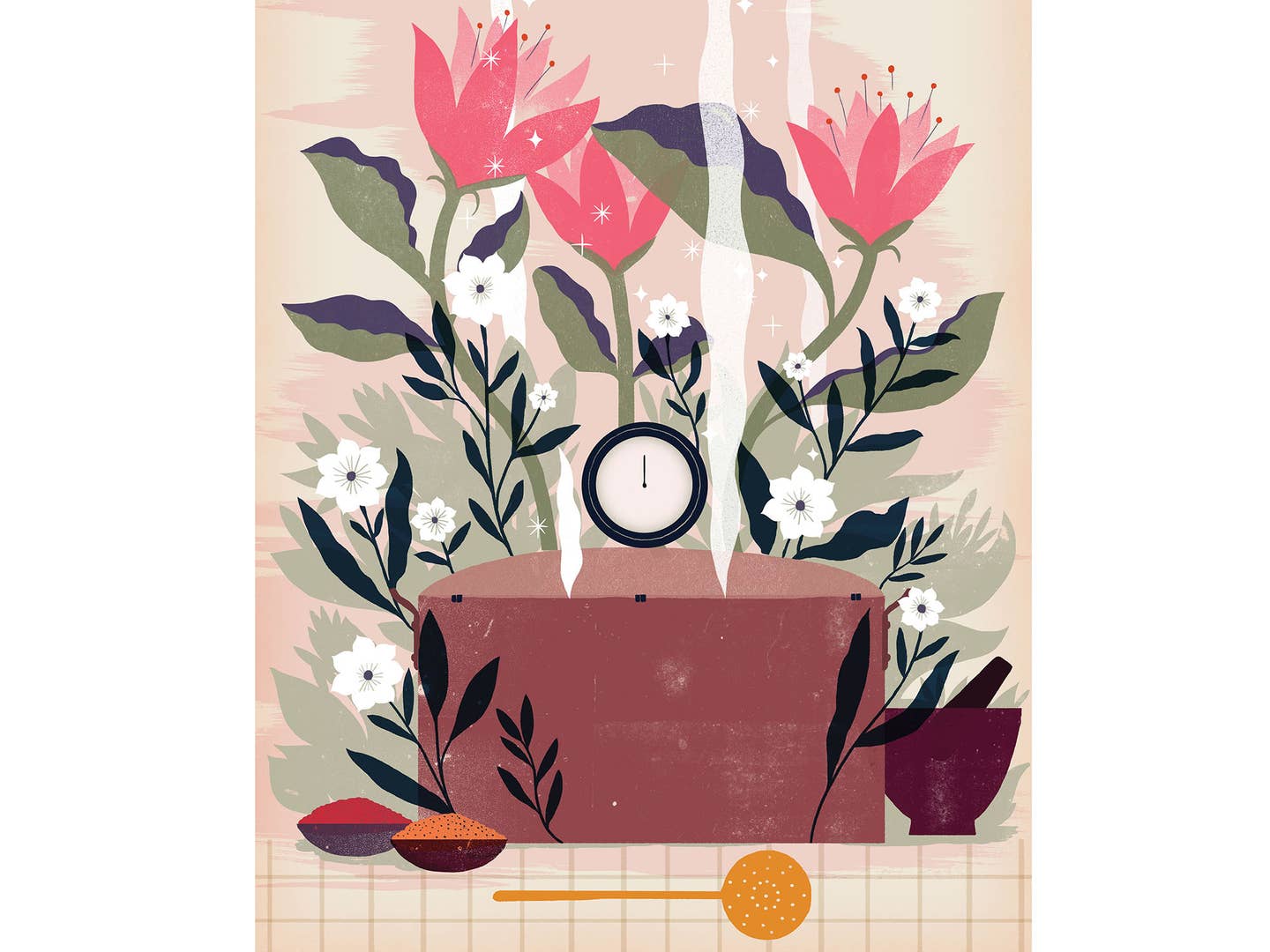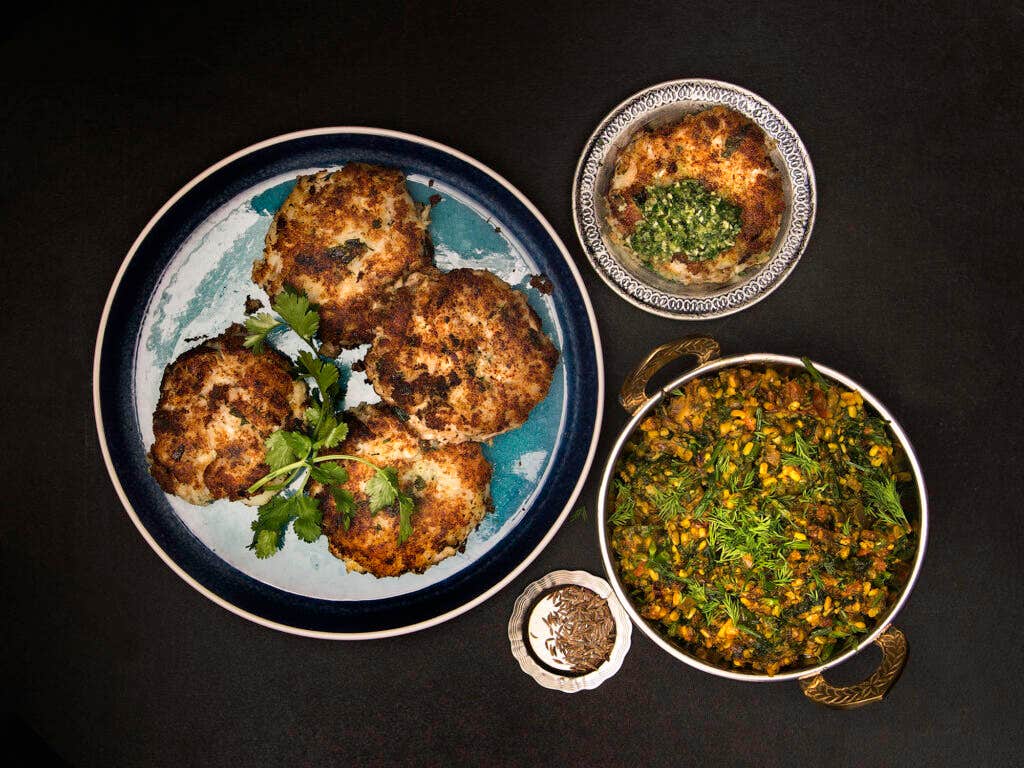
Learning to Cook the Indian Way
Develop an intuition for spices and never forget your pressure cooker
There is no sound I associate more with the three years I spent in India than the whistling of pressure cookers. For the first two years, though, this constant aural accompaniment to life in our leafy South Mumbai neighborhood was abstract, a reminder that mothers, aunties, cooks, and maids were hard at work in kitchens nearby.
The home my wife and I shared was a studio apartment in an area full of charming, if crumbling, colonial and Art Deco apartment buildings, bordered on two sides by the sea. Our four-story U-shaped apartment block was a short walk from the Gateway of India and Taj Mahal Palace hotel—two of the city's most iconic landmarks—but far enough from the throngs of tourists and the freelance guides, souvenir sellers, and scamsters who flock to them. Life in our neighborhood was propelled by the informal economy of household foods. Vegetable sellers laid out their goods at dawn on tarps on the sidewalk, joined by hawkers of ingredients such as dried red chile peppers, fresh coconuts, and, when they were in season, the superlative Alphonso mangoes. Each morning an elderly man in a pristine white kurta pedaled through the neighborhood on an old bicycle with two enormous milk cans affixed to each side, and "fishwives" in brilliant-colored saris canvassed the neighborhood with plastic tubs full of fresh seafood balanced on their heads, often trailed by fat, feral cats. Even the newspaper dealer, in addition to selling publications in Hindi, Marathi, Tamil, English, and Gujarati, offered several exciting varieties of banana. Taxis parked in the shade and drivers disappeared into their backseats for a solitary fried feast when snack vendors emerged in the afternoon.
My wife had taken a job on the launch of a travel magazine and I worked from home as a writer. We loved Indian food and considered ourselves well versed in it, having eaten it regularly in London and New York, our respective homes. Soon, though, we realized how little of the cuisine we'd truly been exposed to. While living in India, we made a point of seeing as much of the country as possible, and food proved the best introduction to the various regional cultures. It became clear that what we knew was mainly the Mughlai and Punjabi food that defines much of Indian cuisine abroad, but soon we came to prefer things like the spicy, meaty cuisine of Chettinad in the southern state of Tamil Nadu, the mustard-centric Bengali take on Chinese food, and the sweet, bottomless Gujarati thalis that challenged our notions of how much we could eat in one sitting. We came to schedule flights so we could hit our favorite restaurants, including a roadside café near Goa's airport and various kebab shops scattered around New Delhi. The best food, though—what we now miss most living in New York—is what we came to eat at home every day.
At first, Pushpa cooked for us. She was our maid (most expats in Mumbai had maids), a woman of uncommon industry and few words who dressed in the traditional Indian salwar kameez and had long hair twisted into a tight braid. She usually made a lentil stew called dal, along with chapatis (round, thin breads), and a simple vegetable dish, typically cauliflower, cabbage, potatoes, or peas. Nothing fancy.
I had a few abortive attempts at making dal and other favorites. A lesson with a previous maid revealed only the disturbing levels of salt and oil she relied on. Cooking from a cookbook never worked either—I was intimidated by the use of so many different ingredients, especially spices, many of which I'd never cooked with. And a lot of cookbooks I bought either contained westernized recipes or assumed a fluency in Indian cooking techniques that I didn't possess.

Eventually, I asked Pushpa if I could look over her shoulder as she cooked two dishes: dal (limitless varieties of which are found all over India) and sabudana khichdi, a fry-up of tapioca pearls, peanuts, and spices that I fell in love with during our first weeks in India.
Indian kitchens are the domains of Indian women, and Pushpa seemed bemused by the prospect of teaching a Western man. At first I just watched, taking notes in a leather-bound notebook I kept in the cutlery drawer. Soon I was participating, chopping this or stirring that. Our lessons were supposed to be just once a week, but before long Pushpa would let herself in and ask, “Are we cooking today?” The answer was almost always yes.
The pressure cooker loomed large. As far as cooking implements go, it's the most intimidating. Not only do they have a reputation for exploding—the internet is rife with videos of pressure cookers spewing their molten contents—but you can't lift the lid to see how things are progressing. Ours was a particularly terrifying example of the genre. Bought in the local produce market, it had a wobbly handle that needed to be reinforced with scotch tape, and the rubber sealing ring quickly went slack. For some reason, Pushpa had to bang it against the side of the counter to break its seal. But she relied on it for cooking everything from a pot of masala chickpeas to a single potato. She used it because it cooked things quickly—no small consideration when you spend your day cooking pulses—and because rice relies on pressure to become sufficiently fluffy. Mostly, though, it was in the service of her profound frugality, since it required about half the expensive propane to cook things like the Keralan variety of brown rice we favored.
Between her own household and the half dozen she worked in, Pushpa prepared about ten meals a day. She washed and chopped vegetables, rinsed and picked over lentils and rice, and cleaned up with remarkable speed, always seeming calm, never running late. She tasted food by vaulting it from the spoon into her mouth, thinking, mistakenly, that I wouldn't want her eating from our cutlery. She had all manner of tricks, including cooking chapatis directly on the gas flame until they puffed up and adding some water to a flipped-over frying pan lid, which she said helped cook vegetables by allowing condensation to drop back into the pan.
Before long, we settled on a basic division of labor. Out of four dishes, we'd each make two. I loved to get creative with the raita, a seasoned yogurt dish used as a condiment, and I'd make it with carrots, beets, cucumber, mint, or coriander. Pushpa usually handled the chapatis and stuffed parathas, which I could make but only in oblong or malformed shapes. We'd split the difference, with her making the dal and me the vegetables or vice versa. Often I would glance over for validation that the onions were soft enough, or to ask whether I'd added enough spices (usually I hadn't). Pushpa disliked sharp objects and refused to use the paring knife and Microplane I'd brought from New York. She took pride in her ability to open a young coconut by smashing it on the floor without losing any of the precious juice. She also loved arguing with our fruit seller, whom she said was a badmash, "a cheater person." She bragged of beating his prices down and sent back undersized pomegranates and unripe custard apples. She was happy to do the shopping, but was skeptical of a new organic grocery in our neighborhood, seeing it as a pointless extravagance. "You go to Organic," she'd say, preferring to deal only with her network of cheater people.
Our tiny apartment became a laboratory of Indian cooking. All of our closeted clothes began to smell of onions and garlic, and an hour or so after we'd finished, my eyes would water. We began to cook with the ceiling fans circulating the humid Mumbai air at gale-force levels.
Soon Pushpa became prideful about her food, suggesting new dishes and cooking things she'd never made. I had a copy of Pushpesh Pant's heroically comprehensive India Cookbook, which has a thousand recipes spanning the subcontinent, but Pushpa refused to engage with it. It was an affront. If I wanted to make something new, she'd say, "I don't need that book." She wasted nothing, constantly figuring out uses for leftovers, which were often thrown into the dal or stuffed in parathas. Once she foraged in the fridge, emerging with some leftover ends of a fish we'd made a curry out of, a potato, and some wheat bread and turned it all into tikkis, or croquettes, with fried fish. Another time we had a giant bush of leftover dill, an herb always sold in unreasonable quantities. Pushpa cooked the whole thing with lentils and peanuts, creating a dish that was one of the most interesting I'd tasted in India—and have never seen, before or since, on a restaurant menu anywhere. Pushpa always favored "full masala," but I liked to use fewer spices, allowing a couple of strong tastes to stand out, like mustard seeds and curry leaves. We both liked quick-cooking, sweet lentils like masoor or mung dal, and I insisted on minimal oil.
On the last day of our stay in Mumbai, Pushpa didn't let me cook. She made a prawn pulao, a rice dish we had never cooked together before, and presented me with a stainless steel mortar and pestle for crushing peanuts and a hand-cranked coconut grater, subtle reminders of the two ingredients that feature in so much of Maharashtrian cooking. The prawns and the tools were, she said, “gifts from my side.” In return, I gave her the paring knife and the Microplane, which she gingerly accepted and promised me she would come to terms with.
The leather-bound—and now food-stained—notebook is a nice memento of our lessons. I'd hate to lose it, but it wouldn't be catastrophic. I know the recipes by heart. I understand the basic principles of Indian cooking and can read between the lines in cookbooks, employing the techniques Pushpa taught me, which continue to bear fruit.
Now, when people ask me where I go in New York for Indian food that reminds me of India, I tell them I make it myself. I've even become evangelical about pressure cookers, though sadly, the expensive one I now own doesn't whistle.
See the recipe for Fish and Potato Tikkis with Chile and Lime »
See the recipe for Spiced Dal with Peanuts and Dill »
Find more Indian recipes this way »
Keep Reading
Continue to Next Story










